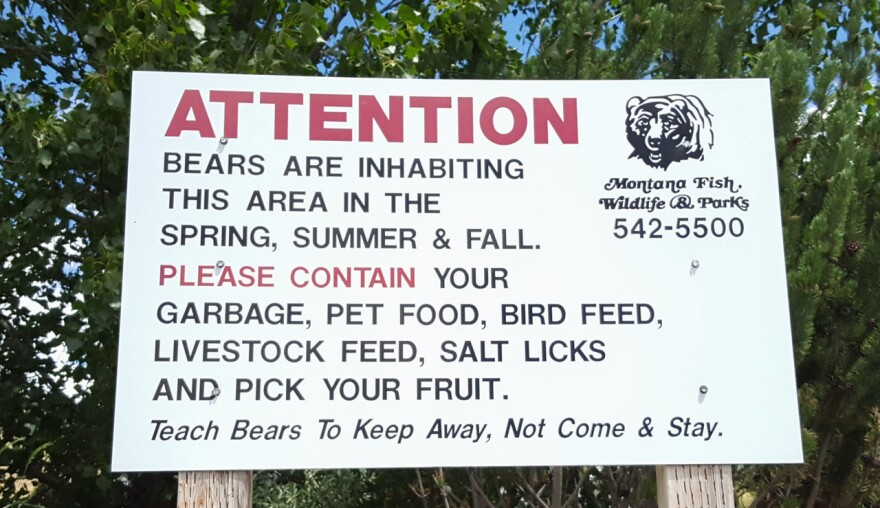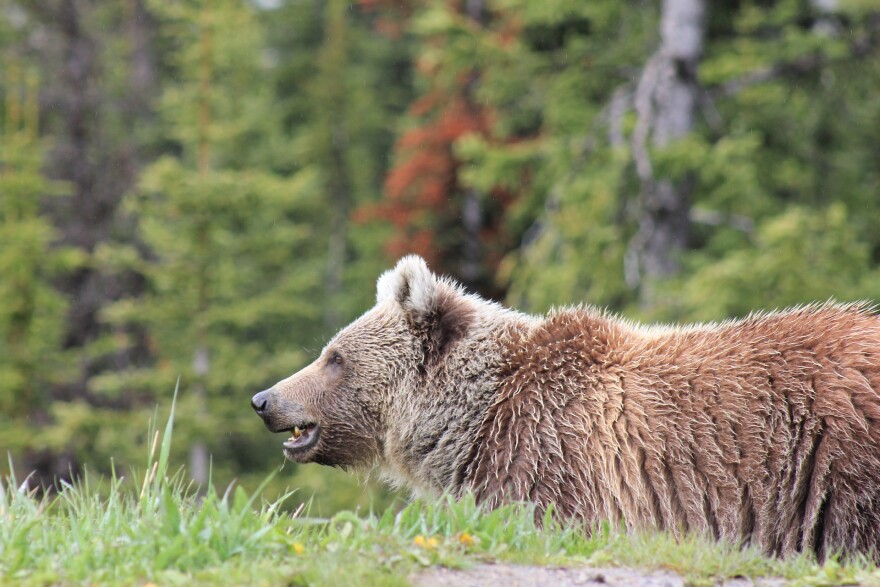This week on the Rocky Mountain Front, state wildlife officials trapped one grizzly bear and killed another when the bears, separately, killed a calf and attacked sheep. Wildlife managers expect more conflicts like this as the number of bears in the region grows.
Grizzly bears have started walking back into their historic territory on the eastern plains, and many farmers and ranchers who haven’t seen the bear in generations are scared for what this revival means for their own way of life.
When federal wildlife managers made recovery plans for this grizzly population after it was shot nearly to extinction, few expected — and no one planned for — the bear to return to the prairie.
On a recent weekday night in the town of Fort Shaw, just west of Great Falls, people are meeting at the local senior center to learn more about the growing number of bears in the area.
Fort Shaw is bordered by the Sun River, which flows east out of the Rocky Mountain Front like some kind of nature highway for creatures following water to more water until they reach the Missouri River.
“For 128 years, we haven’t had to worry about them,” says Jim Pribyl.
Pribyl says his family homesteaded out in this area in 1889. Back then there weren’t any problems with grizzlies, because he says they could just get rid of them, shoot them, if they came onto their property.
The rules for run-ins with grizzly bears are a little different out on the prairie than in the bear’s designated core habitat closer to the mountains. Wildlife managers can be more aggressive about removing or killing bears out here to protect human interests.
Pribyl says the bear shouldn’t be tolerated at all.
“We’re being told you can’t feed dogs on the back porch, you’ve got to secure the grain that’s in the open shed in barrels. You’ve got to all these things because bears are moving farther out on the prairie. Three or four years from now I think there are going to be a lot more problems because there’s going to be more bears. So there’s going to be more and more conflict. I would just hope that the Department of Fish Wildlife and Parks and the Wildlife Service would be very, very aggressive on any bears that get out onto the prairie,” Pribyl says.

Wildlife managers are increasingly playing the role of peacemaker between grizzly bears and humans. Here on the prairie, that job belongs to Wesley Sarmento. Last July he became Montana Fish, Wildlife and Parks’ first ever Bear Management Specialist assigned to the area. At 30, he’s younger than most other bear managers around the state.
At the community meeting in Fort Shaw, he’s wearing a tan long-sleeve Montana FWP shirt tucked into blue jeans. A small spiral bound notebook is in his left breast pocket. He stands in front of images of grizzly bears projected on the one of the room’s walls. There are about 40 people there to hear what he has to say.
“We’re having to live with grizzly bears," Sarmento says, "so it brings to question a couple things. How do grizzlies fit in to our western way of life? And what a can we do to stay safe and deter bears?”
Sarmento is in charge of responding to human-bear conflict. That means he teaches people how to keep their property clear of bear attractants, like garbage and dead livestock. And he shows up when a bear is giving a property owner problems. When needed he captures the bears or euthanizes them.
Sarmento travels a lot responding to sightings of bears, but he has an office in Conrad. It's packed with wooden shelves stacked with binders and papers and radio collar equipment. Half a dozen mounts of bighorn sheep, mountain goat, deer and other stuffed or skinned animals hang on the walls.

“It's very challenging balancing the different viewpoints and attitudes and values around grizzly bears," he says. "There are some people who think grizzly bears should be given the same rights as a human, and there are some people who think grizzlies on their property should be shot on sight. My job is to try to find a balance.”
Sarmento says he took the job because he wanted to be in the middle of all that, spending time with grizzly bears and teaching people about them. He has cousins in the area who work in agriculture, so he says he understands the new conflict that locals face.
“They like grizzly bears, they appreciate grizzly bears; but they don’t like it when a grizzly bear shows up on their back porch, which has happened. And they have a 2 year-old kid, they have a 12 year-old kid, and a 16 year-old kid. And so, that reasonably makes a parent concerned. On the prairie it really is just families trying to make a living, and they’re concerned about their livelihood, and they’re concerned about their own safety and the safety of their children. Their concerns are legitimate and they need to be addressed.”
Sarmento, and other wildlife officials, have been holding public meetings up and down the Rocky Mountain Front in recent weeks, since before bears started coming out of their winter dens.

As bears emerge, Sarmento says it’s important for farmers and ranchers to have a basic understanding of why grizzlies act the way they act.
Because grizzlies were unseen in this area for so long, wildlife managers didn’t make plans for their return until they started showing up in greater numbers in recent years. Grizzlies are still more myth than reality to many of the people who live here.
Sarmento says movies, pop-culture, and media have often shown the bear as a carnivorous beast willing to eat people given the chance.
"Demystifying something is the first step towards understanding," he says. "Everyone is afraid is of what they don’t know. When we were kids, we were afraid of the dark because we didn’t know what was in front of us. And so the first step toward reducing fear and increasing awareness is education."
In the area Sarmento is in charge of overseeing, it’s not as easy to stop bears from coming into conflict with humans as in other parts of the state. It’s the Golden Triangle, Montana’s bread basket. The land is dominated by agriculture and livestock. And Sarmento says he can’t put an electric fence around everyone’s wheat field or ranch.
But bear managers on the prairie can use more force to protect human interests.
Chris Servheen is the retired U.S. Fish and Wildlife grizzly recovery coordinator, a position he held for more than 30 years. He helped lead the effort to recover grizzlies around Yellowstone National park, and to establish different zones guiding how bear managers respond to human-bear conflict, including the area east of the Rocky Mountain Front.
“It is mostly private land and the potential for conflicts is higher," Servheen says. "Now, that doesn’t mean it’s a no-grizzly-bear zone, or that we would persecute bears when they cross the line and enter that area. It just means that we have increased management flexibility. Maybe some bears that get into conflict may be removed on the first time, rather than relocated several times, as they would if they were in the core area.”

Servheen and current bear managers say the zone defining grizzly bear habitat east of the Rocky Mountain Front as part of the Northern Continental Divide Ecosystem may need to change because bears are moving farther east than officials expected.
Federal Wildlife Managers say they’re almost ready to formally move Northern Continental Divide Ecosystem bears off of the endangered species list. But some grizzlies are already moving far beyond the formal NCDE boundary.
Simply put, bears are starting to walk off the map that wildlife officials created for them to live in.
Pushing beyond this imaginary policy border means state and federal wildlife managers might have to shift bear management boundaries, depending on how far east bears walk. Far enough, and the bear could become classified as a federally protected species again, which would mean significant new environmental review for public land use, like cattle grazing, and change how wildlife officials respond to human-bear conflicts.
Even without the complication of dealing with this potential new bureaucratic policy headache, Servheen says addressing human-bear conflict on the prairie is going to take a while to hit the right balance for what’s best for humans and what’s best for grizzlies.
"But I think with good management and careful management where we remove the conflict bears and respond right away to conflicts with bears, so that people know that the agencies are there for them, that we can balance the needs of bears and the needs of people and not have this friction, ongoing all the time. There will always be some level of conflict. But it will be something that'll be managed," Servheen says.
Back at the meeting in Fort Shaw, some ranchers said that humans are at the top of the food chain, and that shouldn’t be forgotten. Others were concerned about who would pay for property that a bear damages, and just how responsive wildlife officials would be when a bear shows up. Others were less worried.
Standing outside after the meeting, Dallas McKay says he’s lived in this area since the early 1970s. Every few minutes a truck would buzz past in the dark on the highway that runs through town. McKay says that while there are more bears now, they’ve always been here.
“If you don’t want to have bears, you need to go where there are no bears. This is where we live. It can happen. It’s part of the life here. It’s kind of like, if you don’t want live by the ocean, you shouldn’t," he says.
Wildlife managers in Montana are preparing for Northern Continental Divide Ecosystem grizzlies to come under state control, potentially in just a few years if the bears are delisted from federal Endangered Species Act projections.
Wesley Sarmento with Montana FWP says that’s expected to start this fall, and full delisting could happen in a couple of years. If that happens, the state could authorize a hunting season for bears on and near the Rocky Mountain Front. That would likely be challenged in court, like the delisting of Yellowstone-area grizzlies last year.


